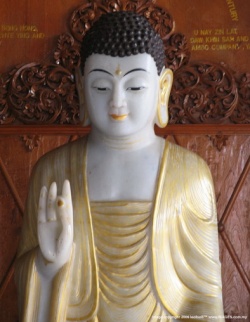Difference between revisions of "Mahāsāṃghika"
m (VTao moved page Mādhyamika to Mahāsāṃghika without leaving a redirect) |
|||
| Line 1: | Line 1: | ||
[[File:Buddha Jap.jpg|thumb|250px|]] | [[File:Buddha Jap.jpg|thumb|250px|]] | ||
| − | '''Mahāsāṃghika''' one of the earliest of the non-Mahāyāna Buddhist "sects" (the so-called Eighteen Schools of Hīnayāna Buddhism), the Mahāsāṃghika has been generally considered the precursor of Mahāyāna. However, although the Mahāsāṃghika and its subschools espoused many of the most radical views later attributed to the "Great Vehicle," other factors and early schools also contributed to the development of this movement. | + | '''[[Mahāsāṃghika]]''' one of the earliest of the non-[[Mahāyāna]] [[Buddhist]] "sects" (the so-called Eighteen Schools of [[Hīnayāna]] [[Buddhism]]), the [[Mahāsāṃghika]] has been generally considered the precursor of [[Mahāyāna]]. However, although the [[Mahāsāṃghika]] and its subschools espoused many of the most radical views later attributed to the "Great Vehicle," other factors and early schools also contributed to the development of this movement. |
| + | |||
| + | The adherents of the self-styled ‘Majority Community’ or ‘Universal Assembly’, a school of [[Buddhism]] which originated in the schism with the [[Sthaviras]] that occured after the Second Council (see Council of [[Vaiśālī]]) and possibly just prior to the Third Council (see Council of [[Pāṭaliputra]] I). The dispute that led to this schism seems to have largely concerned with interpretation of the [[Vinaya]], in respect of which one side took a more liberal approach. A degree of doctrinal difference also seems to have been involved concerning disagreements over the nature of an [[Arhat]] (see [[Mahādeva]]). This school went on to become one of the most sucessful and influential forms of [[Buddhism]] in {{Wiki|India}}, giving rise to several subschools in later years such as the [[Ekavyāvahārika]], the [[Lokottara-vāda]], and the [[Bahuśrutīya]]. Some of the teachings of this school concerning the nature of [[Buddhas]] and [[Bodhisattvas]] have features in common with [[Mahāyāna]] concepts, but since there is no evidence of innovation by the [[Mahāsaṃghikas]] in this respect before the rise of the [[Mahāyāna]], in the view of some scholars, such elements should be ascribed to [[Mahāyāna]] influence. According to this view there is thus not much likelihood that the [[Mahāsaṃghika]] school played a part in the formation of the [[Mahāyāna]] before the latter emerged as a distinct entity. Other {{Wiki|scholars}} see evidence for the converse in the formation of certain [[Mahāyāna sūtras]], such as the [[Nirvāṇa Sūtra]]. | ||
{{R}} | {{R}} | ||
[http://www.academicroom.com/humanities/religion/buddhist-studies/buddhist-sects/mahasamghika www.academicroom.com] | [http://www.academicroom.com/humanities/religion/buddhist-studies/buddhist-sects/mahasamghika www.academicroom.com] | ||
[[Category:Buddhist Terms]] | [[Category:Buddhist Terms]] | ||
| − | + | ||
[[Category:Mahāsāṃghika]] | [[Category:Mahāsāṃghika]] | ||
Revision as of 13:08, 16 July 2013
Mahāsāṃghika one of the earliest of the non-Mahāyāna Buddhist "sects" (the so-called Eighteen Schools of Hīnayāna Buddhism), the Mahāsāṃghika has been generally considered the precursor of Mahāyāna. However, although the Mahāsāṃghika and its subschools espoused many of the most radical views later attributed to the "Great Vehicle," other factors and early schools also contributed to the development of this movement.
The adherents of the self-styled ‘Majority Community’ or ‘Universal Assembly’, a school of Buddhism which originated in the schism with the Sthaviras that occured after the Second Council (see Council of Vaiśālī) and possibly just prior to the Third Council (see Council of Pāṭaliputra I). The dispute that led to this schism seems to have largely concerned with interpretation of the Vinaya, in respect of which one side took a more liberal approach. A degree of doctrinal difference also seems to have been involved concerning disagreements over the nature of an Arhat (see Mahādeva). This school went on to become one of the most sucessful and influential forms of Buddhism in India, giving rise to several subschools in later years such as the Ekavyāvahārika, the Lokottara-vāda, and the Bahuśrutīya. Some of the teachings of this school concerning the nature of Buddhas and Bodhisattvas have features in common with Mahāyāna concepts, but since there is no evidence of innovation by the Mahāsaṃghikas in this respect before the rise of the Mahāyāna, in the view of some scholars, such elements should be ascribed to Mahāyāna influence. According to this view there is thus not much likelihood that the Mahāsaṃghika school played a part in the formation of the Mahāyāna before the latter emerged as a distinct entity. Other scholars see evidence for the converse in the formation of certain Mahāyāna sūtras, such as the Nirvāṇa Sūtra.
